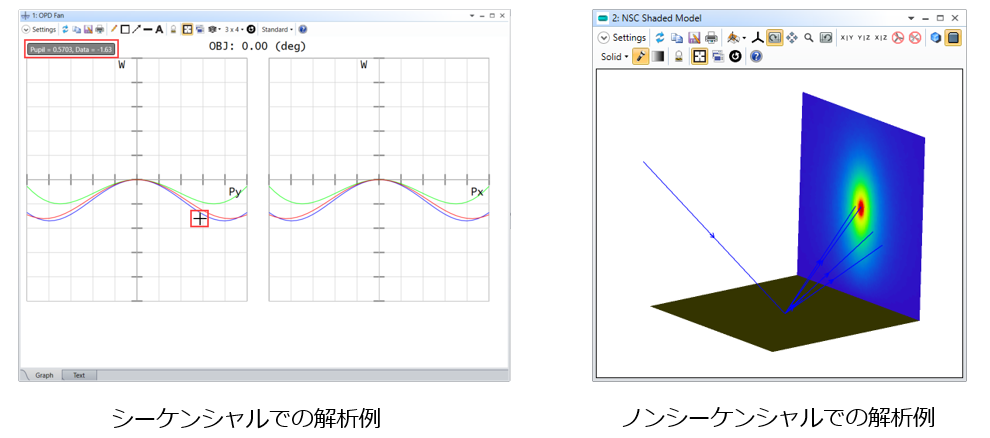Optical learning aims to be a light source that transmits various information under the theme of “optics”. The sources of information are public information on the Internet and some knowledge and experience of the author. This page describes OpticStudio’s “non-sequential ray tracing” along with the differences from the sequential ray tracing.
Conclusion
- Non-sequential ray tracing is a type of ray tracing allowing any order in which the rays reach. Optical phenomena such as refraction and/or reflection are calculated when a ray reaches an object in three-dimensional space regardless of the number of rows of the object defined in the editor.
- Non-sequential ray tracing requires significantly more computational time than sequential ray tracing. This is often used in lighting and stray light analysis because it can track rays that follow difficult-to-predict paths.
Non-sequential Ray Tracing
As a general premise, OpticStudio is a ray tracing software based on geometrical optics. OpticStudio has two ray tracing algorithms, “sequential mode” and “non-sequential mode”, both of which are based on geometrical optics. For more information on Geometrical Optics and Sequential Ray Tracing, see also Geometrical optics and sequential _OpticStudio sequential mode (1). Since the same calculation physics engine is used, if the same optical system is buit in the two modes, the result of ray tracing (the position and angle of the ray) should be the same for each ray.
The worlds where rays can see are different
Non-sequential ray tracing is “not” sequential. I will exlpain about non-sequential ray tracing in terms of the difference with sequential mode.
Sequential mode tracks rays “in order (= sequentially)” of optical surface defined in Lens Data Editor. Therefore, when modeling an optical system as shown in Figure 9-1, we define the order of ray tracing as A → B → C. If the ray cannot follow the order, for example red ray cannot reach surface B, the ray will output an error.
On the other hand, in non-sequential mode, the objects that rays track are “unordered (= non-sequential)”, so the red ray that is not traced in sequential mode can be traced normally and reach the lens after surface C.

To understand this difference, the interpretation that “the worlds which the rays see are different” may be one help. Figure 9-2 shows the worlds where rays (photon) are seeing in sequential mode (left) and non-sequential mode (right).

For the ray that emitted from surface A, photon only see surface B in sequential mode. Note that it’s also important that the edges of lens are not visible too). The tracing of the ray that doesn’t enter surface B is terminated there. This tracing process is continued, surface B can see only surface C and surface C can see only the front surface of the next lens.
On the other hand in non-sequential mode, the rays from surface A can reach the edge of the lens and beyond of the lens if these are there. All objects defined in the non-sequential mode are visible, and if the rays are reachable, rays will be refracted or reflected. Ray tracing is stopped when there are no more objects that the ray can reach.
Other conditions for stopping non-sequential ray tracing are decrease in ray energy, an upper limit on the number of ray segments and some tracking errors. For more information, see the help file, Zemax website, and upcoming Hikari Learning articles.
The fact that non-sequential ray tracing is slow
It’s often said that “non-sequential is much slower than sequential”. I think there are two main reasons. Here, I do not consider the “splitting of rays” due to polarization or scattering, which produces multiple child rays from one parent ray.
(1) It takes time to trace each ray because it needs to calculate until the ray does not reach any object.
(2) The number of rays that need to be traced to get useful analysis results is 100 times or more that of the sequential mode.
Both affect the calculation time in non-sequential mode, but I personally feel that slowness is largely due to (2). As long as both sequential and non-sequential use same geometrical optics, ray tracing itself is processed at the same speed. On the other hand, the number of rays for analysis is very different. For example, for the wavefront aberration plot in sequential mode, enough accurate results can be obtained by tracing 20 or 30 rays per condition (Fig. 9-3 left). However, when analyzing scattering and illumination area’s uniformity in non-sequential mode, at least 100,000 rays should be traced for taking into account noise at the detector (Figure 9-3 right).

You may think “the characteristic that non-sequntial analysis is time consuming is fact, itn’t it?” That’s right! That is why the proper use of sequential mode and non-sequential mode is important in terms of work efficiency. Given the time, it’s best to analyze in sequential mode as much as possible . However, in order to handle the illumination system in the sequential mode, it is necessary to support the optical theory.
Use cases of non-sequential ray tracing
The essence and strength of non-sequential mode is that it does not specify the order in which the rays reach and can take into account all possible ray paths. I think that the scene where the benefits can be maximized is “simulation that requires analysis including paths that are difficult to predict.”
If you can predictk all the paths that the rays will take, you can set all paths in sequential mode even the task should be extremely cumbersome. “How unexpected reflections and scatters on objects at a distance affect the ray distribution on the detector”, such an analysis can never be handled in sequential mode.
The other is the design and simulation of the illumination systems. Why is non-sequential mode useful for for illumination systems? I think major reason is the redundancy of the light source settings. Sequential mode usually assumes a point light source and the angular distribution of rays is limited to basic ones (uniform or gaussian). On the other hand, a light sources in non-sequential mode can set a finite emission area, its energy spacial / angular distribution more complicatedly. The fidelity of the light source model is the most important to the accuracy of the illumination system simulation. I would like to explain this content in another page.
Summary
I explained what “non-sequential ray tracing” is from the viewpoint of the difference from sequential ray tracing in this page.
<References>
[1] https://www.ccs-inc.co.jp/guide/column/light_color/vol16.html



コメント